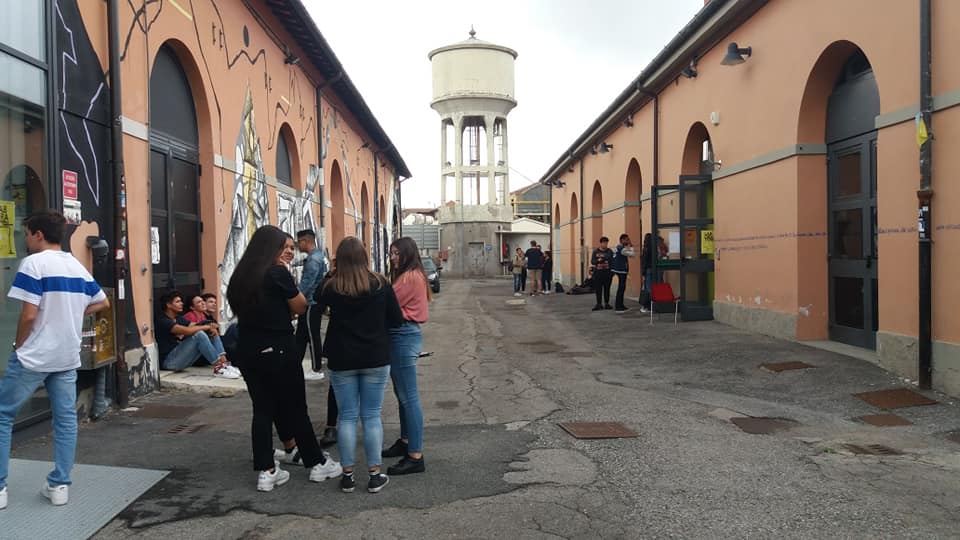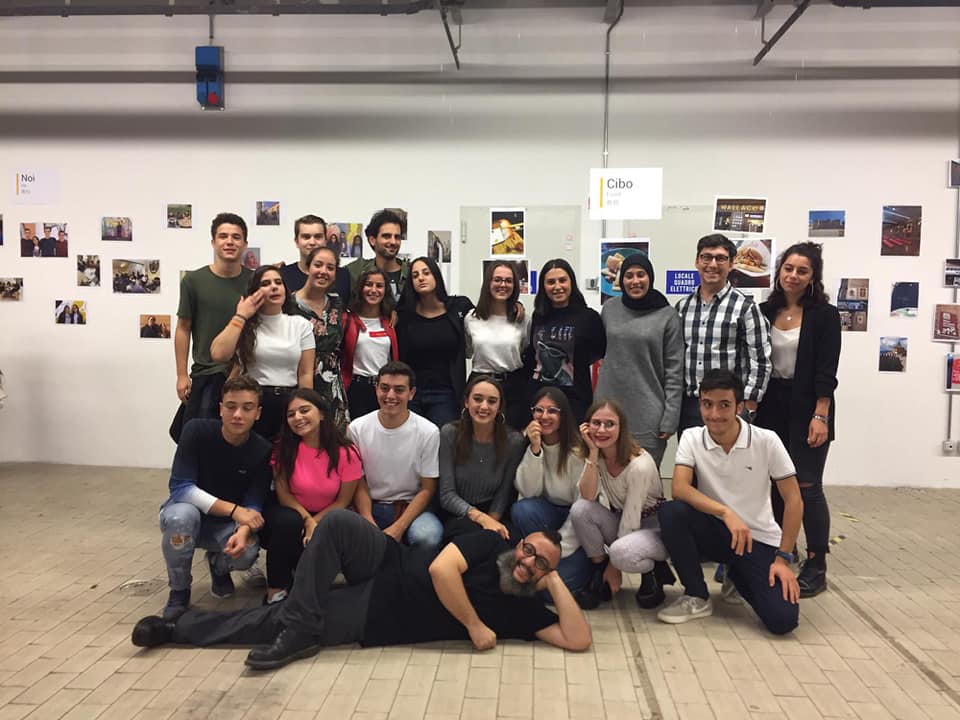The project/workshop/exhibit ended wonderfully! Browse below to see some materials and to know the process.
WHERE: Officina Giovani space (Prato)
WHEN: 30th September – 5th October 2019
WHAT: A creative workshop and a pop-up exhibition
WHO: 7 researchers, 48 high school students, and a week to re-map the city of Prato from their perspectives
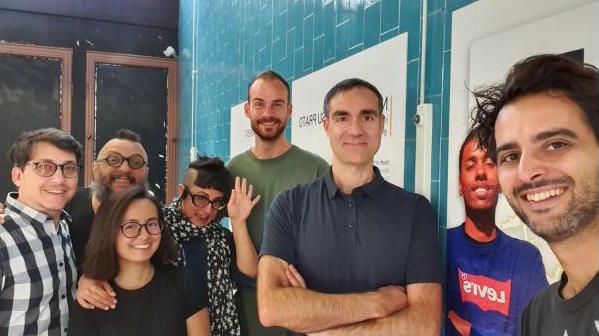
Intro
Prato, 5 October 2019: The historical refrigerating room of Prato’s old public abattoir is buzzing with laughter and excitement as the Youth in the City exhibition nears its official launch. People navigate across pictures, maps, interactive stands and a multi-screen video installation, guided by the forty-eight young urban explorers who collectively produced these artworks over the space of five days. Suddenly the large room is filled with voices in different languages, all speaking at the same time and over each other, as a group of explorers takes centre stage with the performance art intervention that officially inaugurates the exhibition, welcoming everyone into their own re-imagined city.
This brief and powerful moment is the culmination of an intensive and challenging week of creative workshops, in which forty-eight high-school students of different cultural and linguistic background joined us to reclaim their city and present it through their own unique perspectives.
This article reconstructs the days that led to this moment, reflecting on what we learnt as a research team and on the co-creative exploration of Prato that we experienced together with participants.
The workshop was conducted by Francesco Ricatti and Matteo Dutto (Monash University), Luca Simeone, Pieter Overgoor and Yu-Chun Li (Aalborg University), Salvatore Iaconesi and Oriana Persico (HER/AOS). The research group also includes Rita Wilson (Monash University).
What is Youth in the City
Youth in the City is a research project financed by the National Geographic Society (NGS-56467E-19) and by the Scanlon Foundation. Our objective is to realise a digital map of Prato through the eyes of its young citizens, challenging dominant narratives to recognise the creativity and productivity of Prato’s rich multicultural heritage and build a story-telling platform for the encounters and exchanges between different cultures that make it alive. As the students who took part in the project put it:
“With this work we wanted to take back Prato, not just in a physical sense, but in a moral sense, through our own perspectives and imagination” (Youth in the City – Exhibition Press Release published on “La Nazione”).
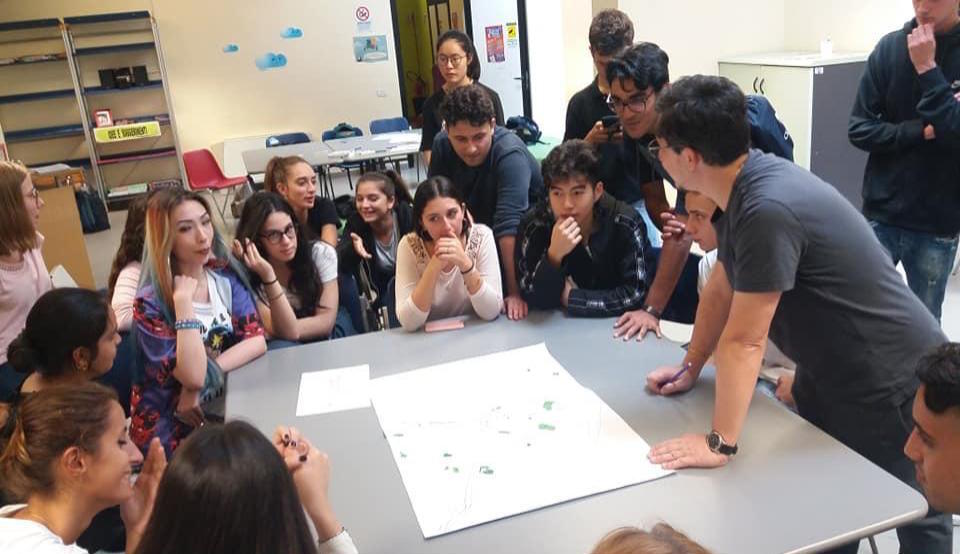
The workshop
The workshop was run in the Officina Giovani space in Prato from Monday 30th September to Friday 4th October and involved forty-eight students from eight local high-schools.
Students were involved in different participatory action focus groups to:
- re-map the city of Prato from their own perspective,
- use ubiquitous publishing tools during creative missions in the field to explore Prato and produce sensorial and emotional maps of the city through narratives, photos, videos, and sound-recordings,
- create an exhibition using these materials.
As a result of the process, participants – jointly with the research team – conceptualized and organised the project exhibition, which took place on Saturday 5th October. The group curated each aspect of it, from the visual design of flyers to the communication plan, set up and launch of the event.
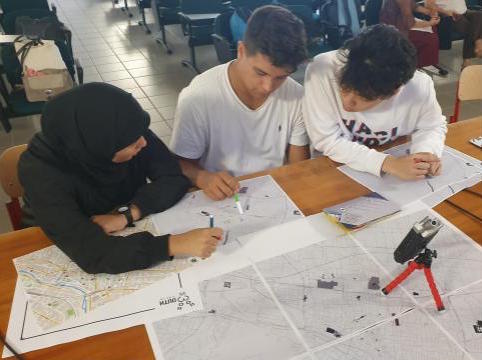
Pre-Workshop Activities
A week before the start of the workshop Matteo Dutto, who is the only person of the group working in town, conducted four two-hour introductory sessions with smaller groups of students in their high-schools. This gave us the chance to introduce them to the work they were about to conduct with us, to familiarise them with the tools that we would use throughout the week and to discuss with them their own expectations and objectives.
Participants used smaller maps to answer introductory questions on how they experience life in Prato. We then used brief questionnaires to collect information about their preferred activities in the city, about the languages they speak and about their encounters and interactions with other cultures in Prato. All this information was used to create well assorted groups for Day 1 of the workshop.
Day 0: the rhythm of the workshop
On “day 0” of the workshop, the team met at the Monash University Prato Center to share the pre-workshop activities and use this information to shape the details of the workshop. This activity allowed us to make some changes and reflect about the rhythm of the workshop.
The exercise was to immerse ourselves in the day by day activities and try to understand if the workshop concept was fluid enough, convincing enough, and suitable for 16 to 18 years old students. One of the most interesting outcomes was the decision to print a series of large scale maps and use it collaboratively during the sessions.
Sources:
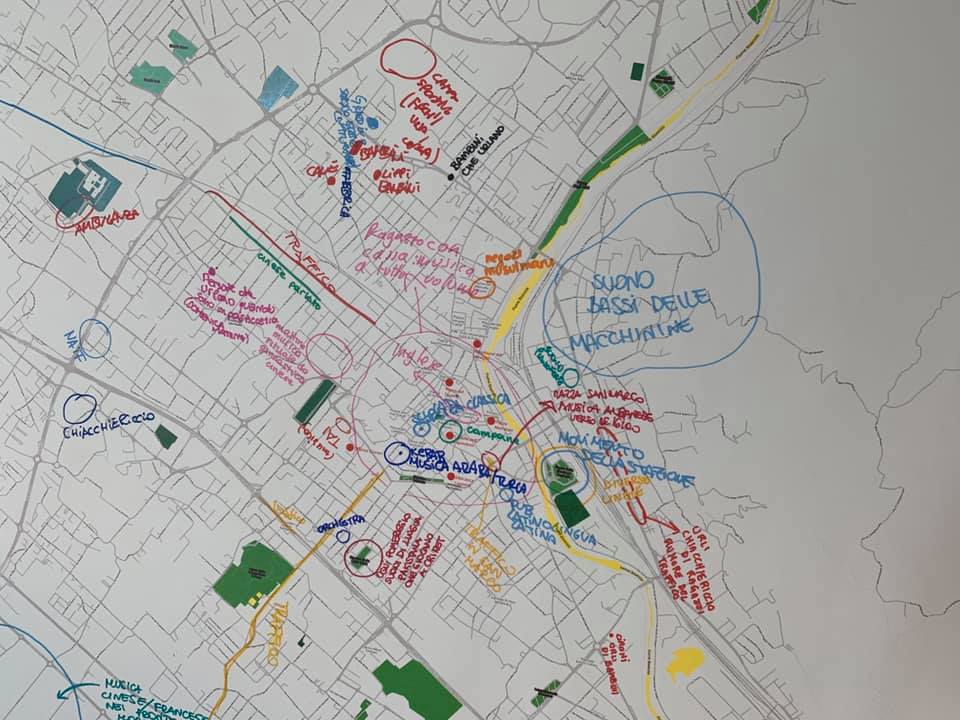
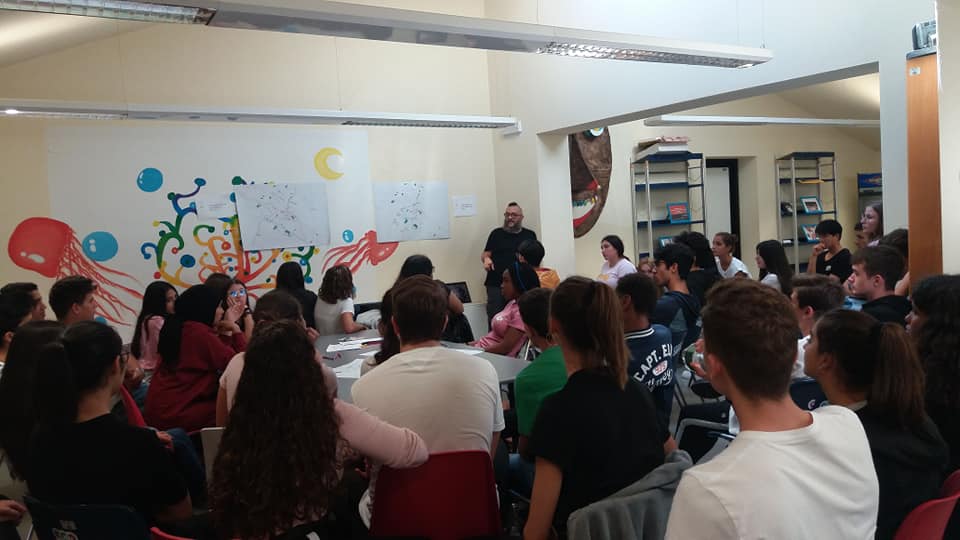
Day 1: Mapping Prato
On the first day the group met the students. After a first plenary session, students were divided into groups, so that students from different schools and speaking different languages could meet and mix. We used the large size maps for collectively adding content to the city on different questions and issues, which were mostly connected to self-representation and linguistic landscape. We attached the maps to the wall and we observed the result commenting on them freely.
The first day was the most intense, also due to the number of questions and issues selected for the session, but the result (the mapping) was of great interest and visually catching: we accurately archived the materials to use them for documentation, for the exhibition, and for future activities.
On day one a small group of students, particularly interested in graphics and design, asked permission to join the Aalborg design group, working on the visuals and the website of the project, and they started to form a new collaborative process. Luca, Peter and YuChun decided to welcome the students: in the following days, they helped them to elaborate visual concepts for the cards and the panels of the exhibit, which were actually printed and used as the visual identity of the project.
Source
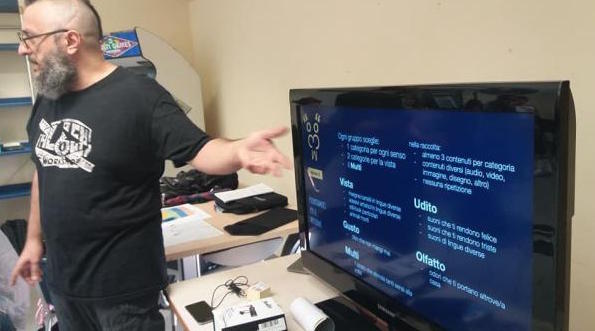
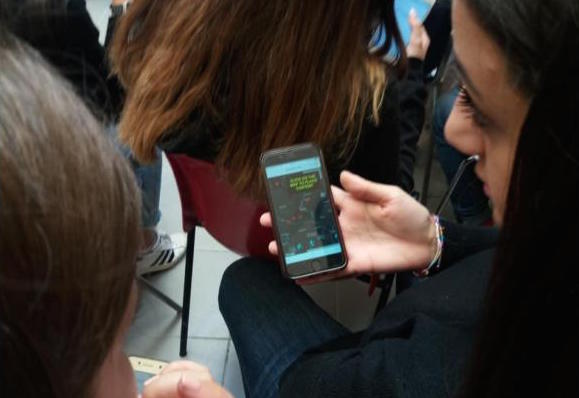
Day 2 : exercise your gaze – experiencing the city through noses, eyes, mouths and ears
On day two we prepared the mission on the ground, for which we created sub-groups of four students. In the morning each group received technological equipment to record and instructions on how to record contents while walking through the city.
What we asked and aimed for was a change in the way students experience their city: we encouraged them to “feel” their city, the spaces they live in and the paths they cross, through some of their senses (the nose, the eyes, the mouths, the ears).
We selected 8 streets and we randomly distributed them to the groups.
In the afternoon, after lunch, students were ready for their first mission on the ground: as a rule, no adults were involved in the missions. We decided this policy also to ensure an autonomous space for the students to express themselves and interact. As part of the mission, students received access to a platform for ubiquitous publishing allowing them to record and add contents (video, text, images, data) directly from their mobile.
Source:

Day 3: Who am I and who are we in the city? Emotions, space, autobiography
Rage, disgust, sadness, joy, surprise and fear. What places make you feel these emotions? Do you belong to those places? Can you occupy/negotiate/transform them through artistic works and performances? Do young people have a voice?
On day three we asked the students to choose an emotion, to connect it to a specific place in the city, and to record a personal memory related to that emotion. Each group was given a set of six basic emotions with the condition to cover all of them: for instance, they were not allowed to have two students in the same group talking about the same emotion.
We immediately got the feeling that entering the zone of emotions and personal memories made a change of perspective in the narration of the city and in the students’ self representation.
Source:

Day 4: preparing the exhibit and the communication plan of #LaNostraPrato
On day 4 a major change happened. Thanks to the two missions in the previous days, students had produced a great deal of material to transform the outputs of the workshop into an exhibition open to the city. As we had planned, from this moment new groups were formed and entered the “production phase”, getting ready to represent the project during a public event and through an exhibition.
The different groups took care of different aspects of the project:
- communication,
- exhibit (divided in the following areas: photos, interactive installation, maps),
- public speaking,
- visual design.
Students had the chance to regroup around their attitudes and interests, ensuring to cover all the tasks needed. After groups were formed, students started working on the different strategies, outputs and goals for the exhibit to happen.
Source:
Day 5: finalizing the exhibit
Day 5: finalizing the exhibit
On day five all the groups worked hard to finalize the exhibit, so that the different pieces of it where in place on time for the opening.
In particular, these tasks were completed:
- Visual materials: complete and send to print visual materials (four different postcards, with four different images, to advertise the event; and panels and signals for the exhibit);
- Photo exhibit: select the most interesting photos taken during the missions, print and organize them into an exhibit, around a concept;
- Maps/Archive: analyze the maps and the data that emerged from the focus action groups during the first two days, organize the data and the material to make the information on the different aspects of the city accessible to a wider audience;
- Immersive installation: obtain, analyze and archive all the video and audio materials generated during the missions and use them to create an immersive experience with the autobiographical memories and the emotional landscapes of Prato narrated by the students;
- Interactive installation: conceptualize and produce a simple way for people to add information about the experience of the exhibit and the mapping of the city;
- Public speaking: conceptualize and perform the presentation of the exhibit to the public;
- Communication: create a press release, analyze the audience, create different messages for different media (social network, wapp, email, telephone); contact external stakeholders; and distribute the press release (both inside schools and classes and outside, to tv, local newspapers and magazines, the local council, etc…).
Source:
Day 6: the exhibit
On day six, everything was ready for enacting the public representation of the workshop in front of the city, the peers (classmates from different schools), families and teachers.
The appointment was again at the Officina Giovani space, in the suggestive historical refrigerating room of Prato’s old public abattoir.
Students started receiving small group of visitors from 3.30 pm. The opening was planned for 6.30 pm, and as a result of the communication strategies, students were able to contact the mayor, and local tv and magazines, sending them social network messages, emails and press releases, and getting them to attend and cover the event.
Source:
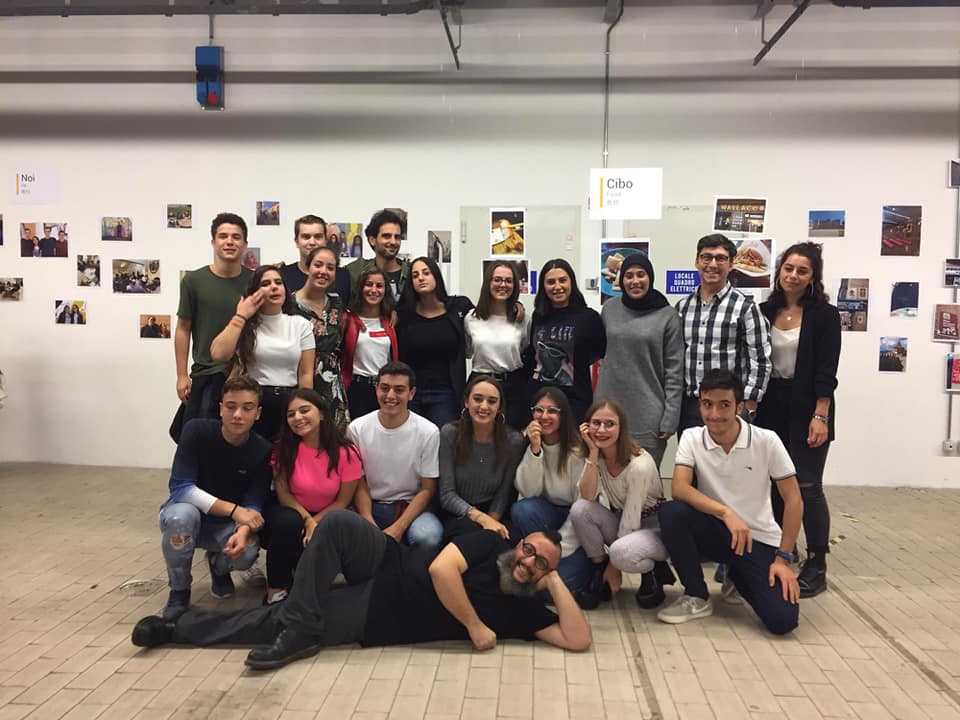
Concluding remarks
This article is a journey through the workshop to describe what happened: as a research group, the week left us with tons of material to process, and in the following months we will release the online experience of the map.
But after this intense experience we have have a few points we are ready to share:
[1] A blithesome relief: we made it!
In only 5 days, 48 high school students from different classes and 7 tutors from different approaches and background (2 of them not speaking Italian) met, mixed, collaboratively conceptualized and produced an enjoyable installation, composed piece by piece with the contents, information, relations and knowledge about the city that had emerged during the various sections and missions of the workshop. This was a stimulating and tremendous reward for everyone involved in the process.
[2] Relations and authorship
Since the first day of the workshop we made clear to the students that the goal was to create a public exhibit, that we would all be authors of the project and that we would all be shown in the credits. Along the workshop we carefully re-negotiated the authorship with students, telling them how the contents would appear, discussing it and making sure they were fully aware of their public position and representation. This also reflected the students/tutors relationship: we tried to create a peer environment in which to be partners, with different roles and specific responsibilities for everyone.
[3] Is this process reproducible (in particular by students, classes, other groups or cities interested…)?
This is an open question for the research group. For the moment what we can say is that we are keen to continue working on this format and experimenting in other cities. In this context, we can highlight some key elements:
- relation with the territory/presence: Matteo, who is living and working in Prato at the moment, was able to establish contact with local institutions and schools, and to provide suitable locations for the workshop and the exhibit (including access to printing services, internet connection, meeting rooms etc…). This is how we managed to organize a complex event involving different actors and location, coming from the outside;
- if you work with high schools in Italy, try to connect with passionate teachers and to “Alternanza Scuola/Lavoro”, the national program for internships. Students are legally obliged to complete work experience for a certain amount of hours, and we made an agreement so that the workshop was certified as an “Alternanza Scuola/Lavoro” project. In this way, students were allowed by schools to spend an entire week with us and take part in the workshop. Passionate teachers are the real gates: they want their students to access opportunities and they want them to be enriched through meaningful experiences. If they trust the project, they will help you to make it happen;
- public and self-representation. The exhibit is a perfect space where the two elements coexist. It is public by definition and if you are an author, you are also personally involved in it: you are acting in the public space and speaking with your voice. This is what happened with the students: they were authors.
As you can see, we still have a lot of work to do with Youth in the City. What we really wish is to make new experiments, in different countries and cities, to promote the self-representation of multicultural youth in cities around the world.
